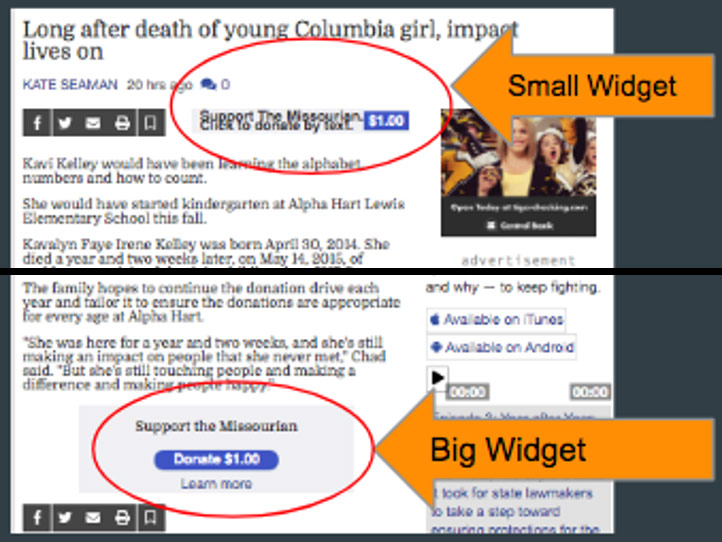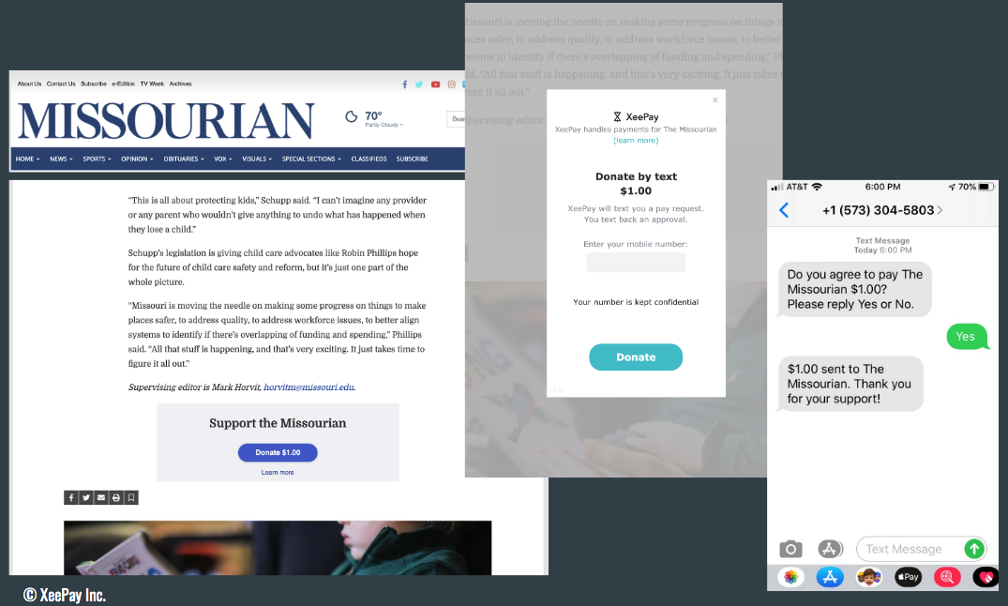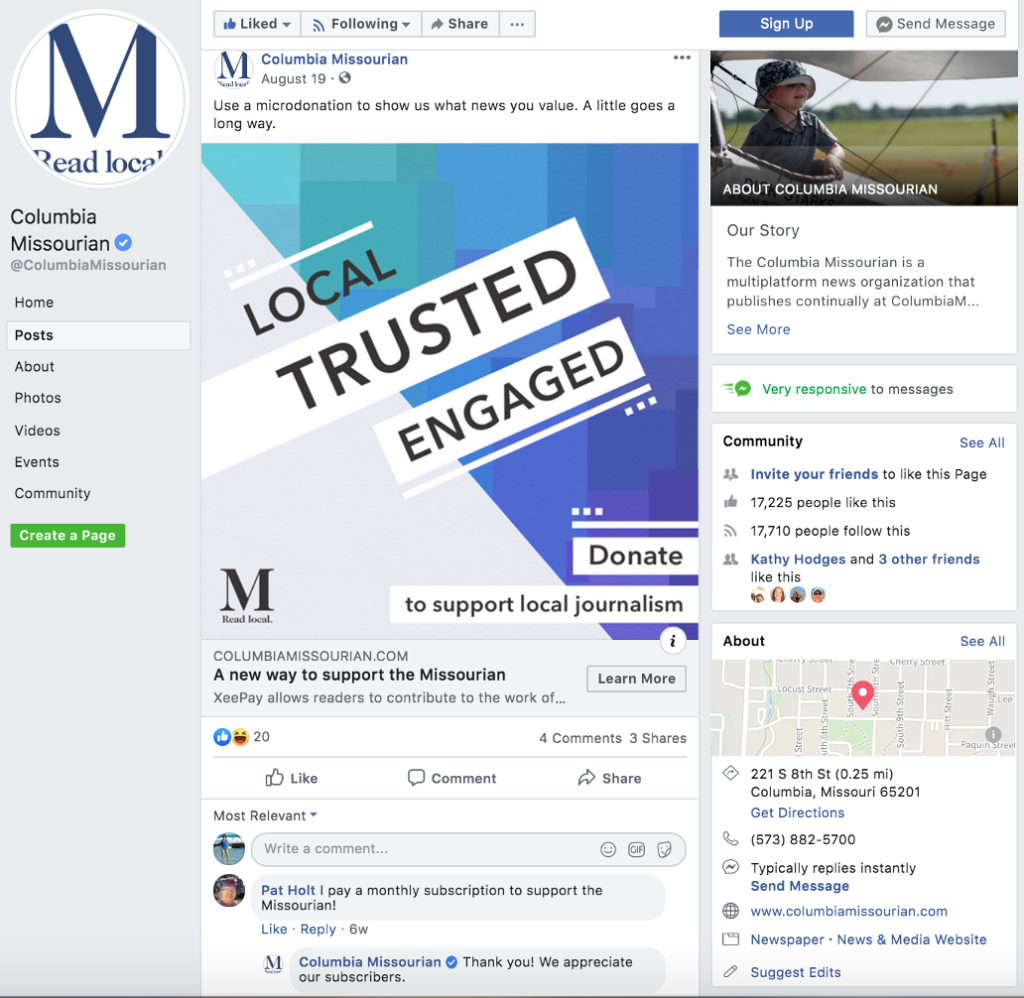
Can pay-by-text micropayments become a viable revenue source for newspapers?
COVID-19 accelerated what we’ve known for some time: Newsrooms cannot rely on advertising. Now more than ever newsrooms need to grow reader revenue — soliciting direct support from their readers.
We have subscriptions. A new study from the International News Media Association (INMA) found that 39% of digital news publishers across 33 countries charged for online news in early spring 2020. But according to the Digital News Report survey conducted by the Reuters Institute and Oxford University, the percentage of American readers who paid for news remained flat at 16% from 2017 to 2019, suggesting that the appetite for subscriptions has plateaued. “Subscription fatigue” may be a factor, given the number of subscriptions a reader is already paying for, e.g. Netflix, Spotify. The same survey also found that more than half of U.S. news subscriptions are going to just two publishers: The New York Times and The Wall Street Journal.
I wanted to explore whether micropayments could do for local news what subscriptions have done for the big national papers. I was able to do a trial of a product, XeePay for News (XPN), which has a direct connection to the U.S. banking system’s ACH network, on a local non-profit newspaper. And that’s how the Columbia Missourian became the first publisher in the U.S. to launch a pay-by-text micropayments donations platform on June 17, 2019. XPN began asking for donations at 50 cents and on Sept. 11 increased the donation ask to $1.
Two results worth noting:
- The click-through rate on the larger widget at the bottom of stories was .37%, slightly higher than the average click-through rate of .35% for display advertising.
- Four out of every 10 people who sent in their mobile number to link to their bank actually completed payment, using text to transact from their bank account.
It’s always a balancing act
The assumption was that the Missourian, a non-profit newspaper affiliated with the Missouri School of Journalism, would be a natural publisher for experiments in reader revenue. But how about its readers?
Elizabeth Stephens, responsible for the Missourian’s audience development efforts, thought the community goodwill that’s been built would help.
“Part of our mission is not just local journalism, but teaching reporters that go out in the world,” she said. “Supporting us at the local level actually supports journalism worldwide. And the pitch we often make is that we provide a public service. It’s the public radio membership drive pledge, identifying that ‘I support journalism,’ ‘I want to do this to continue to support our democracy.’”
But do Missourian readers see it this way? Do they wish to support the Missourian’s mission of training journalists or are they just going there for their daily news? “ I tend to believe that as much as we’re a university paper, we are a community daily,” general manager Bryan Chester said.
Bruce Moore, circulation manager, wondered, “How can I take this and convert people to subscribers?”
The Missourian team, owing to its affiliation with the School of Journalism and the Reynolds Journalism Institute, has embarked on a number of revenue driving experiments. Rob Weir, the former director of digital development, said he always heard the usual “it’s just one line of code” implementation promise. Taking a macro view, Weir cautioned, “if we’re going to ask for readers to pay in a different way, how do we make sure that we’re not flipping our business model or doing something that’s going to cause us long term damage?”
Acceptance, messaging and positioning
Stephens, who aside from audience development is also responsible for community outreach, started researching how other publishers got the donation messaging in front of readers, starting with The Guardian and PolitiFact.
In the beginning, the Missourian’s widget said just one word: Donate. “It becomes wallpaper after a while,” Chester said. “I don’t know that we did a good enough job of attaching value to the ask; of explaining the act, process and cost of journalism.”
The XPN widgets only appeared on article pages. Chester wanted a more prominent location and a notice on the homepage. On longer investigative pieces and special reports, Weir thought they could note the specific value in terms of costs in people and time to report them.
Weir also provided an insight into the dropoff in conversions. While four out of 10 people completed making a donation from their bank account, there are myriad reasons for the drop off. One of them could be that readers are accustomed to online banking but may use touch ID on their phone. “So it’s entirely possible that they could’ve gotten to that step and backed out at the last minute as they didn’t have their password memorized..”
Weir continued, “The friction points were clicking on the thing initially, getting the text to opt in, logging in with your info and then paying. That’s four steps. But I don’t know how you would reduce it because you want to get the confirmation that that’s the actual person, and you have to have them log into their account for the ACH to work.”
Learning about the Missourian reader
The Missourian still has a large percentage of print only subscribers. Moore recounted the questions he gets when a person calls inquiring about subscribing: Do you have advertising inserts? Do you have grocery ads on Wednesday and department store ads on Sunday? Do you have obituaries? Do you have Dear Abby? “These things…they’re like soap operas, readers want to see them every day.”
Would a subscriber also donate as well? Chester believes subscribers would say, I already pay you $6 a month, I’m not going to pay per article. “We’re targeting a different set of people that want to donate because they just read a great story. ”
Stephens’ audience numbers indicate local readers, who spend more time and dig deeper on the site, form around 16% of the Missourian’s total traffic. They are a target for donations and subscriptions. She also found subscribers spend more time on the site – over four minutes per session – and go a lot deeper. “So part of our pitch, of even the $5.95 subscription, is ‘be a supporter of the Missourian and journalism ’… I see micropayments as fitting into that same strategy.”
The customer acquisition funnel
The Missourian does not have a paywall. Its digital subscription offer is for $5.95 month or $7.95 with print delivery. Subscriber benefits include bypassing Google Surveys, access to digital archives and to its original editorial cartoons, and print edition delivery. Moore believes it’s about “changing that attitude that the value of the product is $0, that what we do is worth something. If they can see the value and they donate, especially if they donate repeatedly, those people we can convert to paid subscribers.”
Weir contrasted the creation of digital products that people may be willing to pay for, against what people, “in the heyday of newspapers,” were paying for. “They were paying a subscription fee because it had news, but it also had coupons, classified ads, advertising inserts, TV listings, comics, Sudoku, bridge – that has all been stripped away. So now if we’re asking people to pay for news, we have to figure out what it is that we’re offering that people are willing to pay for. And it might not be a traditional news product.”
Executive Editor Ruby Bailey suggested that donations could be linked to an added value. “Maybe it’s the way we package our sports, maybe it’s highlights of the year – the best games, best commentary, best photos; and we ask for a suggested donation of $1.50.”
Stephens could see XPN providing a way to do day passes, especially when significant local news breaks. “A former Mizzou J-School student writes for the San Francisco Chronicle. When wildfires were going on in California, I wanted to read her stories. But I’m only going to read her stories on that day …. I’m not going to commit to the monthly charge.”
And of those readers who already donated? Stephens added that they could be re-messaged about donating again. Once a user has registered their mobile phone and bank account details, they do not have to repeat those steps – making it seamless for readers to donate again.
Moving forward
Here are some takeaways to consider if you’re interested in a text-based donation strategy:
- Different stories, different messages:The XPN widget was put on 80% of story pages. There was no differentiated pricing or messaging distinguishing longer, investigative pieces from shorter articles such as college sports reports. It would have been interesting to experiment on different pricing and messaging for different story types. Publishers should communicate the work and resources that went behind these stories – the time it took to investigate and write, the number of journalists (and photojournalists) involved, the cost of FOIA and Sunshine requests. Simply asking readers to donate without explaining the cost of journalism, especially for these featured investigative pieces, seemed less effective. There was also a sense of message fatigue around the donation message, in the same way that readers have trained themselves to avoid display advertising. Mixing up, customizing, and refreshing the messaging would certainly be more work intensive, but may reap better results in getting readers’ attention.
- The end goal is still a subscription: All interviewees agreed that driving up subscriptions is their ultimate goal. Donations may come from “fly-by” readers and visitors, but a subscriber has the potential to be a customer for life. Micropayment donations could serve as a customer acquisition funnel to subscriptions. The Missourian can develop a direct relationship with a reader, potential donor, and a potential subscriber. Using XPN, that relationship pivots around the reader providing their cell phone number. All recognized that a careful plan around re-marketing to readers’ cell phone numbers would need to be developed. There may be city, state, and federal regulations about re-marketing via text that need to be vetted.
- To survive, digital news publishers must innovate: The Missourian team recognizes its leadership role in non-profit and local journalism. The team has championed innovation within The Missourian newsroom. We can learn much from reader revenue trials and product innovation happening at The Missourian and other newsrooms. We’ve seen how innovation around reader experience and messaging in Scandinavia has lifted reader revenue there, surpassing advertising. We can also look to innovation happening in other industries, such as music, where consumers have moved from records to streaming.
For digital news publishers to meet their readers’ needs while sustaining a credible business model, innovation in digital products, experiences, and monetization must happen. Innovation could make the difference between survival, and a news publisher closing its doors.
Appendix
After working in the media industry for more than 25 years, Celia Wu decided to pursue a master’s in journalism and was able to use her graduate project to focus on an area she cares deeply about – the survival of local journalism.



